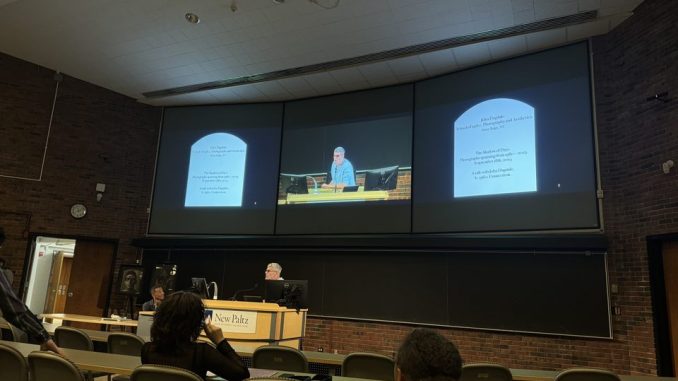
On Sept. 18 at 10:30 a.m., the Student Art Alliance (SAA) held the first of many of their Visiting Art Lecture Series in Lecture Center (LC) 100. This art lecture series was hosted by John Dugdale, a world-renowned fine arts photographer.
Third-year ceramics major Heather Bissett is the president of SAA, an organization that promotes the arts both on and off campus. In addition to their guest lecture series, the alliance hosts a multitude of events ranging from open studios to museum trips. The alliance has had an on-campus presence for 15 years and hosted more than 200 professional artists.
Dugdale’s presentation filled the entirety of New Paltz’s largest lecture hall — from faculty to students to locals. There were moments when the audience echoed with laughter and at other times everyone’s eyes were filled with tears.
His interest in photography stemmed from the ripe age of 11, when his mother gifted him a camera. “It’s good to be unsure of what you’re doing. You will find your way by doing anything that comes to mind,” Dugdale said.
Dugdale presented his work in over 25 solo shows, appearing in collections at the High Museum, the Miami Art Museum, the Metropolitan Museum of Art in New York City and the Los Angeles County Museum of Art in California. Two of Dugdale’s world-famous art pieces are now featured in the Dorsky Museum on campus. “People see what they want to see in the pictures, so they can explain it to me,” Dugdale said.
In his second year of college at the School of Visual Arts in NYC, Dugdale was presented with an opportunity that would change the trajectory of his life. He took black and white photos of flowers to be published in a book that his friend composed.
In 1993, at the age of 33, Dugdale lost all vision in his right eye and approximately 80% in his left eye due to an AIDS-related stroke. Still, Dugdale persevered, as his photography gave him an outlet. “I always try to keep things lighthearted or else maybe I would’ve died,” Dugdale said.
Though his art filled him with joy, Dugdale was afflicted with this new reality. In his lecture, Dugdale described his physical and mental struggle to get back into photography. Dugdale went on to share that he, “slipped a little in the grass, fell and cried [his] eyes out because [he] couldn’t take a picture.”
During such a pivotal moment in his life, Dugdale found comfort in his favorite artistic tool: his camera. “When the shutter opens and closes, which is kind of a mythical moment with a large form camera, you can feel the air running through it and that’s beautiful. Two patches of metal open up for a moment and the light is engraved on the film, quiet and slow. It was the only time I felt peaceful during that time,” Dugdale shared.
Navigating textures while being unable to see them with the naked eye can be difficult, but Dugdale has found his own creative way. “By touching a little carving, I could see the whole thing in my mind,” he said. Further detailing his vivid imagination, Dugdale that said he “still dreams in full color, rarely blind.”
Dugdale’s photography appears in a 1999 issue of the New York Times in a featured story, “Fearless Vision Brings an Artist Home.” Reporter Christopher Mason wrote that “The signature azure tint of [Dugdale’s] photographs, whose vintage allure derives from an obscure process invented by Sir John Herschel, the 19th-century British philosopher and astronomer.”
As part of his own style, Dugdale’s photographs feature an arch shape on the top. Dugdale’s work utilizes cyanotype — one of the oldest photographic printing processes, dating back to 1850. Cyanotype is a slow-reacting technique that “uses a mixture of iron compounds, which when exposed to UV light and washed in water oxidize, create Prussian Blue images,” according to the Parallax Photographic Coop.
Additionally, Dugdale has worked as a commercial photographer for clients such as Martha Stewart, Ralph Lauren and the kingpin of modern luxury, Bergdorf Goodman.
Since the loss of his eyesight, Dugdale has explored other art forms. Thanks to an ear for music, he was able to learn to play the piano, simply from listening to the keys and figuring out the correct ones as he goes along. “You don’t have to go blind to find your way. Believe me, there are better ways to do that,” Dugdale said.
Dugdale attended an AIDS campaign in San Francisco, CA in the early 90s. Onlookers pestered him repeatedly asking, “‘Are you protesting? Are these political statements?’” He said, “Well, if they are for you that’s fantastic, but I didn’t make them with that in mind. Being blind defined the odds and surviving the AIDS crisis and making something out of it — and being shy — trying to hide it that way killed me. So in that way, they are political, but they don’t start that way.”
“The problem is that I’m so emotional and when I laid down, I started to cry. It was such a relief to be seen by all of these people,” Dugdale said.
Dugdale’s story is an inspirational testimony of perseverance, dedication and advocacy. While a smile slowly crept upon his face before an audience with eyes full of tears, Dugdale said, “People think blindness is so dark, but it is so colorful.”
To read more of Dugdale’s inspirational story and view his photographs, visit www.johndugdalestudio.com.
